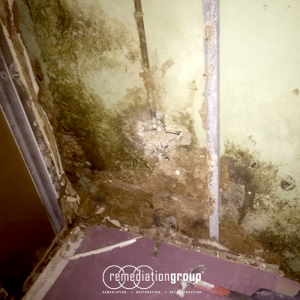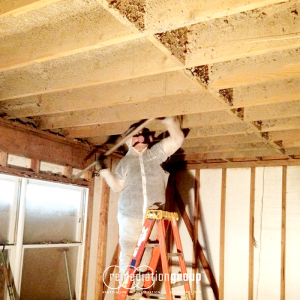&*&*&
Case Study #1 –Dream Home Disaster
Earlier this year, I received a call from Mr. and Mrs. Smith, a homeowner in Buckhead – an affluent area of Atlanta, Georgia. She asked me if I could come out and perform an initial mold assessment– the second round of mold testing on the $1.7 million home she and her husband had recently purchased.
I pulled into the driveway of the large, Southern-style home and immediately noticed the quaint carriage house in the back. It was easy to see how the homeowners had come to love this charming place. It was equally heartbreaking to hear the story of how this dream home had become a nightmare for this couple.
Mrs. Smith had been through a lot in the past few years. With a history of breathing problems, hypersensitivity to mold, and only 30% of her original lung capacity, her options were limited to putting herself on the waiting list for a lung transplant and doing whatever she could to ensure that her living space was clean and free of mold problems.
During the interview, I was told that just before Mr. and Mrs. Smith had closed on the property, they hired a home inspector to perform a structural inspection. Home inspections are a routine method buyers use to determine the condition of the structure and equipment within the home. During the inspection, Mrs. Smith expressed her concerns about the breathing environment of her future home. The inspector assured her that he was qualified to test for mold and added indoor air testing to his list of inspection items.
The day of closing drew nearer and nearer, but Mrs. Smith had not heard back yet about the test results. Would her dream house pass or would she have to keep looking? She finally received a call from the inspector one hour before the loan closing. He assured her that the house was clean, and that the air samples had come back showing that there was not an elevated level of mold in the air. They closed on the property that day.
The following week, Mrs. Smith walked the property with her General Contractor. She was anxious to go over plans for the renovations they would soon undertake. As she walked through her new home, Mrs. Smith’s throat began to close – a symptom she recognized from her prior exposure to mold. She asked her contractor to recommend someone else to inspect the property to make sure that this reaction was not caused by mold in her new home. That call came directly to me later that day.
Although my initial assessment was limited to just a visual inspection, it still revealed visible mold on exposed beams in both the unfinished basement and within the carriage house. It was hard to believe that only two weeks earlier, a home inspector had not noticed this growth. I continued the interview with Mrs. Smith and her husband, noting the size of the home and the carriage house – over 4,500 square feet in all – and inquiring about the previous inspection. Did the inspector take samples outside for comparison? How many air samples were taken? Which rooms were tested? Did they use any other sampling methods, such as viable tests or lift tape? Surely after Mrs. Smith had expressed such concern over the air quality, the inspector would have covered every base.
Unfortunately, that was not the case. The home inspector took only a single air sample from their prospective home and looked no further. I shook my head in disbelief and reminded myself that although it takes only a little training to learn how to perform an air test, it can take years of experience to learn what to look for and how to get the most accurate readings possible. If the air sampled is too far away from the actual mold colony, it can lead to inaccurate results and false negative results.
After the initial inspection, I performed additional visual inspections, moisture readings, relative humidity readings and an occupant history survey, then recommended additional testing by a third-party. Two weeks after purchasing the house, the Smith family received their second preliminary mold assessment, stating that the basement, the main level living space, and the carriage house all contained visible mold levels in the air and surface samples.
If the inspector had understood the importance of looking at what creates conditions to sustain mold growth in the home, he could have prevented the Smiths from buying a badly contaminated home or at least saved them a great deal of money in mold remediation cost.
There were three obvious problems.
- There was obvious visible mold on floor joist and sub-flooring in the crawl space. The crawl space did not appear to have water leaks but moisture and humidity levels were high. Foundation vents were allowing hot humid summer air into the space and the humid air was condensing on the floor joist and sub-flooring.
- An addition to the home had been built on a concrete slab. The moisture in the floor measure higher than normal and plywood was laid over the concrete and a vapor barrier over the plywood. Hardwood flooring was laid directly over the vapor barrier covering the plywood. Moisture rising from the concrete slab created conditions for mold growth on the plywood. All of the hardwood flooring and the plywood sub-flooring had to be removed and discarded as a result. If the mold inspector had used a moisture meter in his assessment, looking for conditions that sustained mold growth as well performing air tests, he would have known conditions existed in the floor to sustain mold growth and performed a more in-depth investigation.
- On a wall that was not designed as a retaining wall, the grade around the home rose three to four inches above the floor level for about ten lineal feet. Moisture form the dirt had migrated into the exterior wall and created conditions for mold growth.
Basically, the overall condition of the Smiths home was in such poor condition that in order to ensure Mrs. Smith would have a healthy air home to live in, I recommended and provided extensive mold remediation, waterproofing, crawl space encapsulation, crawl space dehumidifier, partial removal of several walls, duct cleaning, a HealthyAir DVA (dehumidification, ventilation, air filtration) system, removal of molded flooring over a concrete slab, some air duct replacement, upgraded air filtration systems and finally the sub-flooring in the crawl space was coated with a closed cell foam insulation.
Stephen Andrews provided clearance testing for the Smiths after RGI completed all the mold remediation and other recommended air quality up-grades. Stephen claimed the air quality was as clean as a modern hospital but more important to me, Mrs. Smith is completely satisfied with the air quality and feels safe inside her home.
Fred Rodriguez
Fred Rodriguez, Remediation Group, Inc. (RGI) is a certified, qualified, and insured mold remediation firm, serving the state of Georgia.
&*&*&
























